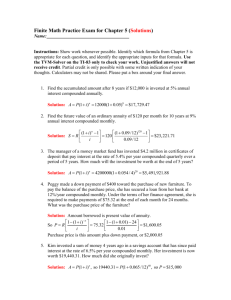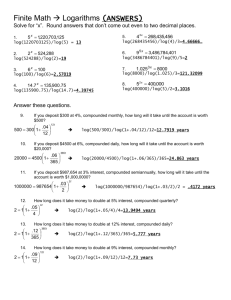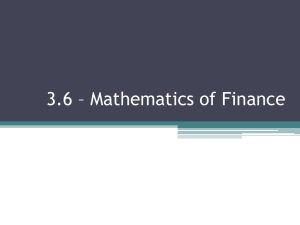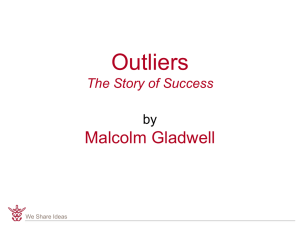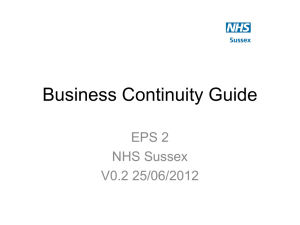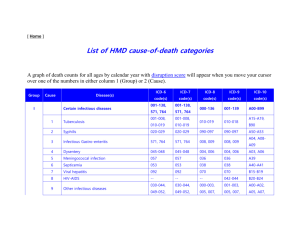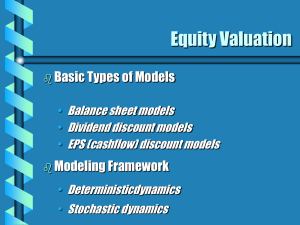SSG – Sections 3, 4, & 5
advertisement
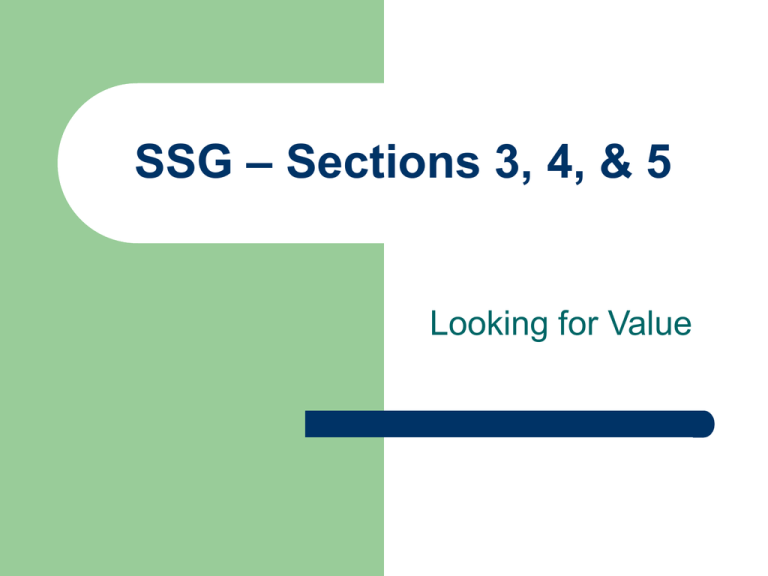
SSG – Sections 3, 4, & 5 Looking for Value Recap of Section 1: Reasonable insider & institutional ownership; Reasonable debt: Preferably under 33%; Double-digit growth in the most recent rolling 4 quarter review; Clean railroad tracks on Visual Analysis; Double-digit historical growth (look for 15%); Estimate sales and earnings no greater than 20%. Recap of Section 2: Pre-Tax Profit stable or increasing; Higher than industry and competition; Preferably 15% or more. Return on Equity stable or increasing; Preferably 15% or more. Recap of Quality Issues If the company does not pass the Quality Issues…do not move on to Sections 3, 4, & 5. Bad-Quality companies look great on the Value Issues! On to Value! Section 3 – P/Es and Outliers First, remove any outliers that don’t seem to fit the pattern. Can you find them in this grid? Section 3 (cont.) Notice the change in the average high and low P/Es when we remove the outliers. Section 3 (cont.) Compare the new average P/Es to the 5-year average and the current P/Es. Section 3 (cont.) Now check your estimates on the front of the SSG. Are your P/Es realistic? What is the PEG? It shouldn’t exceed 1.5x your 5-year EPS estimate. Section 3 (cont.) What if the High P/Es looks like this? Ellis says cap the high P/E at 1.5x the PEG, but never more than 30. Section 3 (cont.) And what about the low P/E? The 5-year average low, or the lowest in the last 5 years, will be your best choices. Section 4 – High Price In this visual, we’ve capped the high P/E at 30 and multiplied it times our estimated future EPS from Section 1. This gives us our high price. Section 4 – Low Price Toolkit uses the last full year’s EPS to calculate the low price. Section 4 – Low Price (cont.) But some prefer to use the next 4 quarters EPS since we “are” looking into the future. Section 4 – Low Price (cont.) Here are our options There are many differing opinions on the selection of low price… …but Ellis says to be mindful of your selected P/Es and earnings, then choose Option #1. Section 4 - Zoning Toolkit automatically figures the zones, which we have set to 25/50/25. Section 4 – Understanding Zoning Potential High Price $100 Sell 1/3 Top of Maybe $70 1/4 Maybe 1/3 1/4 Top of Buy $40 Buy Potential Low Price $10 1/4 1/3 1/4 3:1 UpsideDownside Ratio $30 Section 4 – Relative Value Once you have found a “buy”, always check the Relative Value. We’re looking for 85-110%. Section 4 – Relative Value (cont.) Relative Value: Current P/E divided by Signature P/E Tells us whether we missed something when we addressed the “quality” issues. Lets us know if the price is unusually high or low. A call to investigate. Section 5 – The Final Section Section 5 gives us the results of our efforts; • Total annual return, and • Compounded annual return. Section 5 (cont.) Total annual return is our estimated growth divided over 5 years. Without the power of compounding, we need 20% to double our money every 5 years. Section 5 (cont.) And on the other side, we have our compounded return. Here, we only need 15% to double our money every 5 years. These are best-case scenarios! Section 5 (cont.) But also notice the Projected Annual Return. This is our selected EPS x the average P/E— a more conservative compounded figure. This is an option you must select from your Preferences Tab in Toolkit. Summary of Sections 3, 4 & 5 Either eliminate outliers or cap your high P/E at a PEG of 1.5, not to exceed 30. Use the average 5-year low P/E, or the lowest P/E in the most recent 5 year period. Consider using the forward 4 quarters for your estimated low price. For growth stocks, use Option #1 for low price. Summary of Sections 3, 4 & 5 Always set the zoning for 25/50/25 to ensure we have a true 3:1 upside ratio. Look for a Relative Value between 85 & 110. And look for an compounded rate of return of at least 15%, which will double our money every 5 years. (See the handout for more specifics) The End

